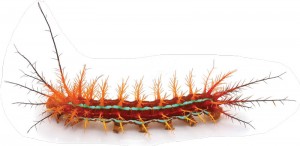El Hinchdor, Fuzzy Fire & a Couple of Other Things That Can Ruin Your Vacation
Every place in the world―from the polar regions to the deep ocean, from the streets of a big city to the tropical rain forest―has its own particular hazards, of which you need to be aware. If you live in the city you learn about the dangers there and how to deal with them. It’s the same when you live in the jungle. When you’re walking around in a rainforest it’s a good idea to watch the path so you don’t step on any snakes; everyone knows that. But there are lots of lesser known dangers, things that you may not have heard about, that can cause you grief. These include everything from chiggers to stingrays. Some are better known than others and some have interesting stories. Here we’re going to have a look a couple of insects and plants that you may not know about but should definitely be careful with.
El Hinchdor
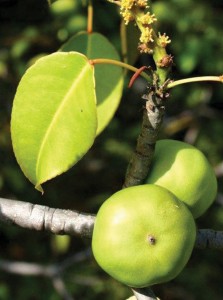
On one of Christopher Columbus’ early voyages to the Americas he landed on an unnamed island in the Caribbean in search of food and fresh water. The sailors, crazed with thirst and hunger, hurried ashore in hopes of finding relief. The first tree they found lining the beach was full of a luscious ripe fruit that smelled similar to what we know today as juicy fruit gum. The half delirious mariners, not familiar with it, crammed the fruits into their mouths and swallowed hungrily. According to the ship’s log 17 men died from the poisonous walnut-sized fruits of the manzanillo tree (Hippomane macinella).
The manzanillo, sometimes called “Manchineel” in English, is locally called “El Hinchador” in Spanish, meaning one that causes swelling. You don’t have to eat the fruit in order to feel the wrath of this highly poisonous tree, simply remaining in its shade for an hour or so can cause you entire body to swell.
A young friend of my son’s once picked up one of the tasty smelling fruits, placed it under his nose and inhaled the delightful aroma. Fortunately, someone stopped him before he had a chance to taste the reddish-yellow flesh. The experience cost him a minor caustic burn on his fingers where he picked it up and a severe caustic burn, that took over a month to heal, on his upper lip and the underside of his nose.
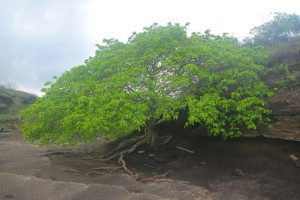
I once suffered a similar burn on the right side of my face, including the eyelid and the side of my nose. I first started treating it as I would any other skin irritation, but without success. After trying several remedies with similar results I consulted a medical doctor, who didn’t know what the burn might be, but prescribed another treatment which also failed. On the advice of an employee, I consulted a pharmacist who specialized in herbal remedies. He took one look at my face and said, “You’ve had an encounter with El Hinchador.” He told me that I would have to be patient because the burn of the manzanillo tree takes a long time to heal, but he gave me an herbal remedy to soothe the discomfort and facilitate the healing process. On the return trip to Hacienda Barú from San Isidro that day, I reminisced with Diane about my movements the day the burn first appeared on the side of my face. I had been near the beach on horseback. Retracing my steps, I remembered that a tree branch had brushed the right side of my face as I rode down the trail paralleling the beach. Arriving home in the late afternoon we unloaded the supplies we had purchased in town and drove out to the spot where the branch had brushed across my face. Sure enough the tree was a manzanillo. I hadn’t paid any attention at the time, but I certainly pay attention now.
This wonderfully shady but very inhospitable tree often attracts unsuspecting visitors who do everything from hang their hammocks to spread their picnic lunches under its inviting boughs. On Hacienda Barú we have warning signs where they are found. We wouldn’t want you to ruin your vacation because of an encounter with El Hinchador.
Fuzzy Fire
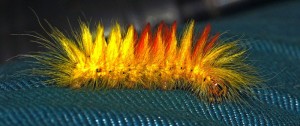
Tiny Costa Rica boasts an abundance of butterflies, and that means lots of different kinds of caterpillars. There are large, brightly colored and elaborately patterned butterflies and small, plain, insignificant ones, and likewise there are all extremes in caterpillars. In fact some of the most beautiful ones come in vibrant, almost phosphorescent, tints and have long, fuzzy hairdos. Some even have tufts of long hairs sticking out from many different parts of their plump bodies. The colors, striking oranges, greens, blues and yellows in all different shades, are some of the most beautiful I have seen. I have seen fat, fuzzy caterpillars as long as 10 centimeters (4 inches) and others which are small and sport much less fashionable hair styles.
One evening Diane and I were watching a movie on television when I felt a minor irritation on my left shin, like a tickle. Reaching down I tried to scratch it through my blue jeans, but with the first pressure something made me stop, an unpleasant feeling that I couldn’t define but somehow knew was serious. I quickly stood and removed my jeans, shaking the left pant leg to remove whatever was bothering me. A small, fuzzy, orange caterpillar fell to the floor. This was one of the less fanciful ones described above.
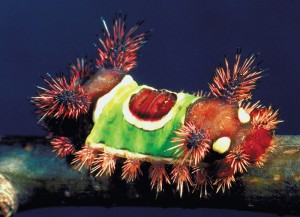
By that time the burning sensation and pain had begun to build. The only way I can describe it is that the discomfort penetrated all the way to the bone. It was a combination of burning and itching, but the itching was deep and I knew that scratching wouldn’t help. None of this unpleasantness was intense. I remember thinking at the time that maybe the caterpillar was overrated as a poisonous pest. Stories I had been told, which spoke of extreme levels of pain and discomfort, may have been exaggerated.
Thankfully, the caterpillar I had encountered in my pant leg was quite small and, although a pretty orange color, wasn’t especially impressive. It lacked the beautiful long tufts of hair and other adornments found on some of the more poisonous ones. In nature any bright colored and very visible insect or other animal usually has some sort of built in defense, and the high visibility serves as a warning to potential predators. Usually the brighter and more obvious the color pattern the more poisonous the animal.
Several days after the incident I noticed that the burn on my shin wasn’t healing properly. A few days after that the itching began again. It wasn’t superficial but as with the original discomfort seemed to be deep seated and penetrating all the way to the bone. It was like no itching I have ever experienced. Nothing seemed to alleviate the feeling which persisted for more than a month. Finally the burn healed over completely but the itching continued for at least another month at a lesser intensity. Eventually it stopped altogether and today only a brown scar about the size and shape of the caterpillar remains to remind me of my only encounter with fuzzy fire.
Learn from me, please don’t pet the pretty caterpillars!
Yummy, Let’s eat a Cashew
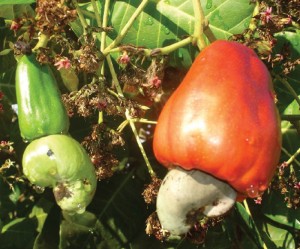
The cashew tree provides such a beautiful shade, and it smells so nice. They are common in the tropical lowlands of Costa Rica and bear fruit from February through April. Several years ago, a girl named Yemaya was a volunteer at Hacienda Baru. Her friend Jenny showed up one sunny February afternoon with a bag full of raw cashews. Yemaya really had a craving for cashew nuts at that moment, so she popped one in her mouth. As soon as she bit down on the raw seed she suspected something was wrong. Nobody had ever told Yemaya that the uncooked seed of the cashew (Anacardium occidentale) is extremely poisonous. You could compare it with eating a salad of poison ivy.
Fortunately the outer shell is very tough so she wasn’t able to penetrate it with her teeth. However, just having the seed between her teeth and biting down on it was enough to release a tiny bit of mist from the outer casing. That’s what caused the tingling in her mouth that gave her second thoughts. Realizing that something was wrong, she came looking for me. By the time she found me, a half hour later, her mouth was already numb. I offered to take her to a doctor, but she refused.
The next day Yemaya’s lips and the corners of her mouth were all blistered and inflamed and her entire body broke out in a rash. She applied some cream to the rash, and went to work, confident that it would clear up. The second morning her entire face was swollen and hot, and the rash had spread to the rest of her body. She insisted on going to work, but nearly fainted about 9:00 AM. Ignoring Yemaya’s protests, my wife Diane rushed her to a local clinic where they gave her an IV and two antihistamine injections. She had to stay out of the sun for three days, take medication, return for another injection the following day, and take things easy. Yemaya was fortunate that she didn’t bite down harder.
The fruit of the cashew is shaped somewhat like an apple with a single cashew seed attached to the bottom of it. The fruit is edible, having a pleasant tarty taste that will make your lips pucker. The seed is encased in a very tough shell which, if penetrated, is extremely caustic and will cause severe burns and alergic reactions.
When local Costa Ricans prepare the seeds for consumption they cook them outside of the house because the fumes are so toxic. The processing is done over an open fire with a large rounded plate called a “comal.” The cashew seeds are dumped in the hot “comal” with some cooking oil and everybody stands well back from the fire. Not until the outer shells are burnt to a crisp and fumes no longer rise from the cooking cashews will anyone go near the fire. Once cooked the nuts are fine to eat.
So if you have a craving for cashew nuts I recommend that you buy them at the grocery store. Yemaya does.
An Unwelcome African Visitor
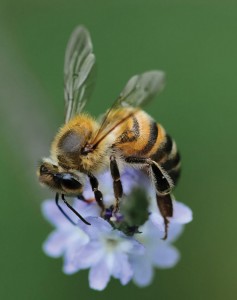
In the late 1980s the USDA worked on a joint project with the Costa Rican Agricultural Ministry in an effort to stop the northward migration of the Africanized Bees. They chose the region where Hacienda Barú is located because it is the narrowest point in Central America. I don’t think the effort even slowed the bees progress. About two months into the project they received word that the bees presence in El Salvador had been confirmed and a year later they were in the United States.
Most of you have already heard of the so called “killer bees.” They really aren’t that much different than ordinary honey bees except that they produce more honey and have a nastier temper. The sting of one Africanized bee is no more dangerous than that of any other bee. They are dangerous because they tend to attack over very slight provocation and do so in force. If you work around an apiary where the Italian honey bee is in residence, and you bump one of the hives, maybe 30 or 40 bees will chase you for 30 or 40 meters or less. If the same thing happens in an apiary with Africanized bees as many as 300 or 400 bees may chase you as far as 300 or 400 meters. That’s the difference.
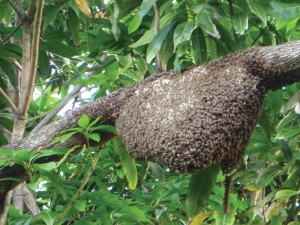
There are no more pure Italian honey bees in Costa Rica. Their hives have all been invaded by African bees and their gene pools diluted. But in the process the more aggressive African bee’s genes have also become diluted. The farther they have migrated northward and interbred with more of their easier going Italian cousins the calmer they have become. Bee keepers have learned to work with them, and in the long run, not much has changed. We still have honey, but we have to be a little more careful around bees.
If you’re hiking through the jungle and see a hive of bees, please steer clear of it. If you get too close to the hive the bees may attack you. If this happens, remember the following.
- At the first sign of a bee attack, usually one or two bees stinging you, leave the area quickly and put lots of distance between you and the place where you were attacked. Even though you may not have seen the hive, you were certainly very close to it. The hive is what they are protecting, so move far away from it.
- Don’t swat at the bees. If you do, they will release a pheromone that incites others to attack.
- Don’t make noise.
- If the bees are in hot pursuit, run in a zigzag path if possible.
When we were scouting Hacienda Baru for just the right tree to use for the canopy platform, a birding guide named Jaime, who is also an excellent climber, and an arborist named David ascended a strangler fig near the mangrove by working their way up the convoluted surface. The normal procedure would have been to get a line in the tree with a bow and arrow or sling shot, pull a climbing rope up and over a sturdy branch and scale the rope in the manner used in our tree climbing tour. In this case, due to the many good hand holds on the strangler, they simply climbed free hand. About 20 meters (65 feet) above the ground they spooked an iguana that quickly scampered down a branch and into a hollow section of the tree which turned out to contain a hive of Africanized bees. As Jaime tells the story they slid and scrambled down the tree at a dangerous pace receiving a number of bruises and scrapes in the process, but no falls. Each suffered a couple dozen bee stings but, fortunately, they acted quickly and were able to put enough distance between themselves and the hive before the whole mass got into an aggressive mood.
There have been about a dozen human deaths in Costa Rica from killer bee attacks and another dozen domestic animal deaths. In most cases the victims were trapped somewhere and couldn’t get away from the bees. In recent years we have noticed less and less of them. The attack described above is the most serious we have had on Hacienda Barú.
Look Both Ways
In conclusion I would like to reiterate that none of the things described in this section are any more dangerous than walking the streets of a big city, they are just different. With that in mind, when your vacation is coming to an end and you return to San Jose to catch your flight home, please look both ways before crossing the street!

